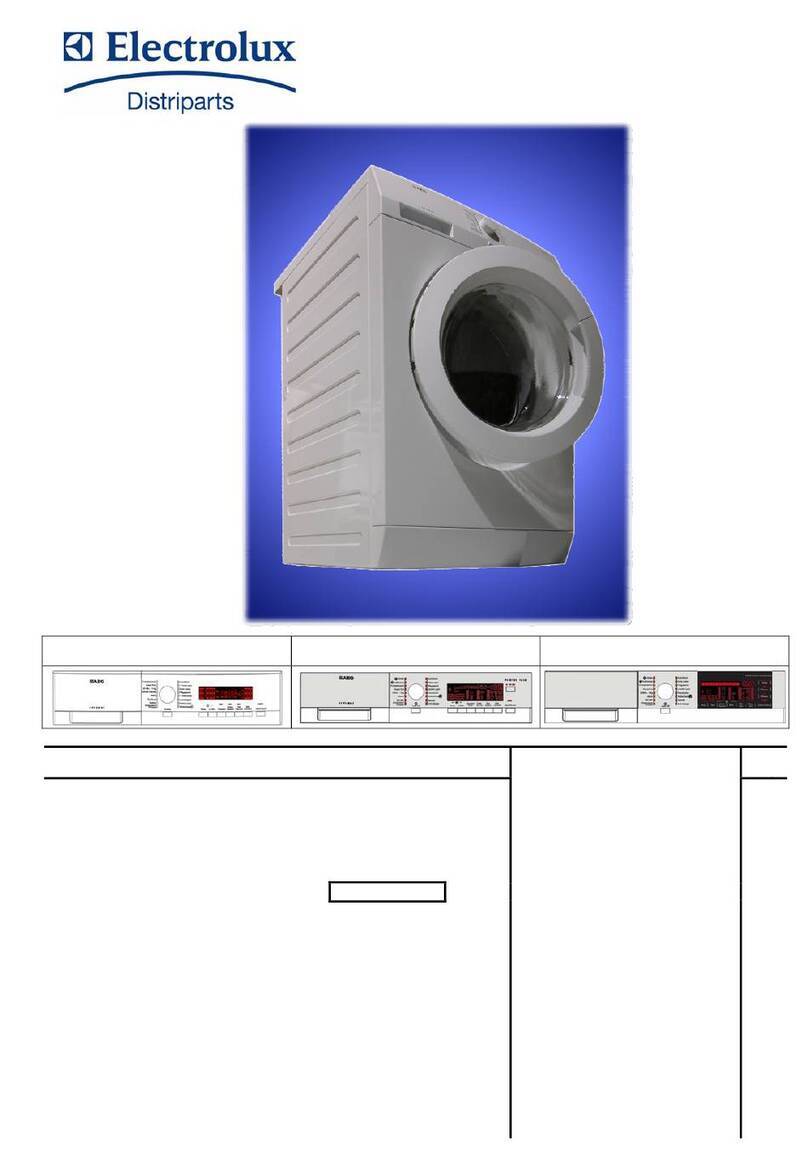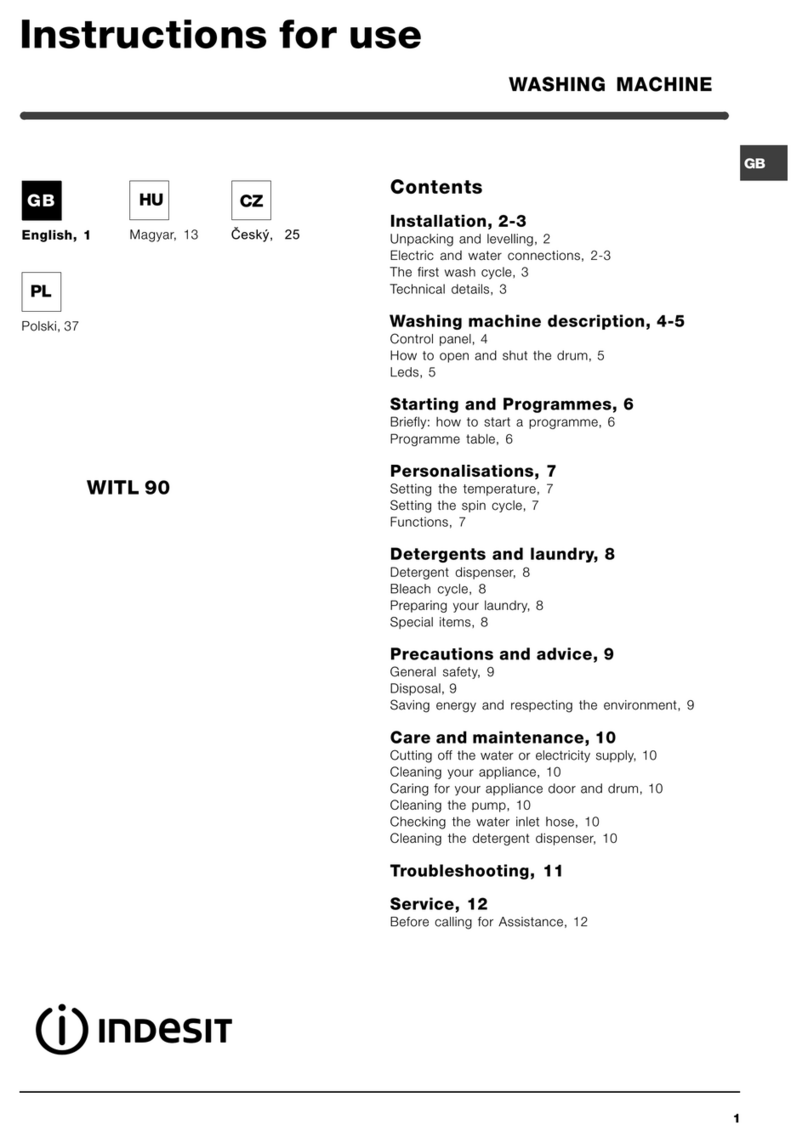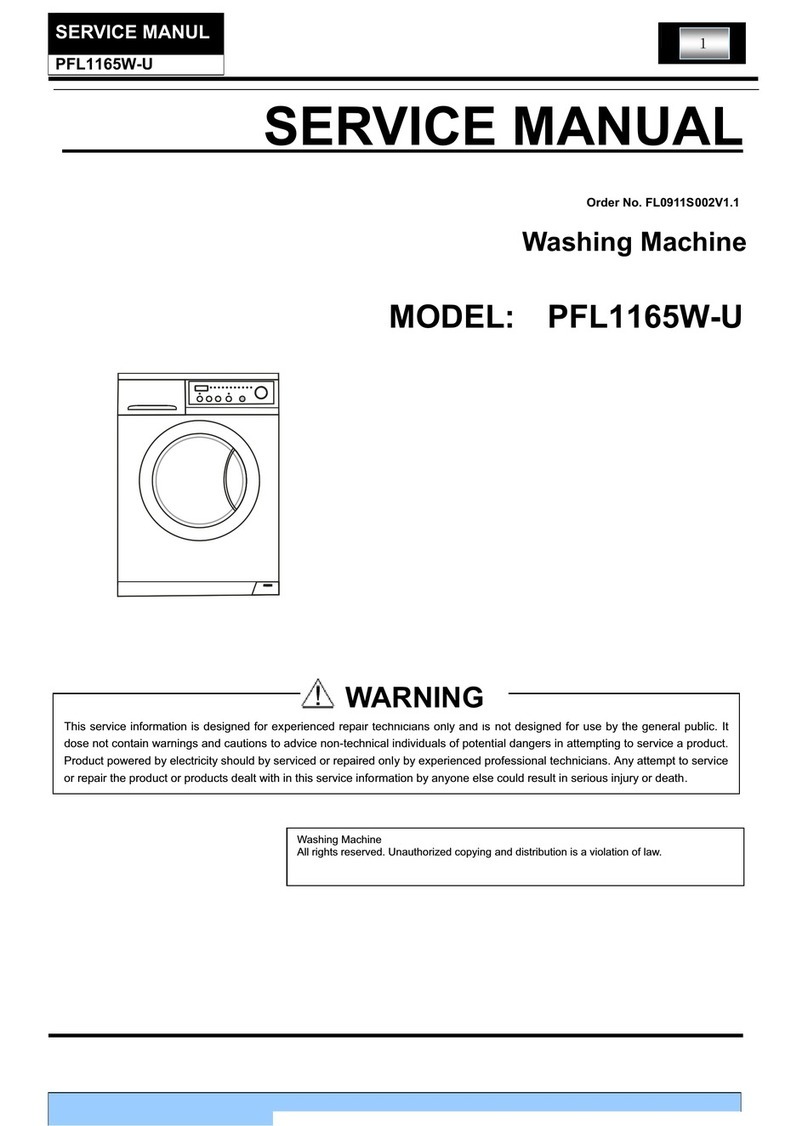Smart Brand SB8544 User manual

Operating Instructions
Washing Machine
Smart Brand SB8544

4
Before using your machine for
the first time
4Transport protection
4Packing material
4Washer door
4Checking water hardness
5Safety instructions
5General
5Installation
5Overflow guard function
5Transport/Winter storage
5Recycling
6Child safety
6Keep an eye on children!
6Automatic door opening
7
Description of the washing
machine
7Detergent compartment
8Front panel
8Options button
9Advice and tips before washing
9Sorting your laundry
9Clothing
9Laundry labels
9Laundry label symbols
10Coloured cotton
10Unbleached linen
10Wool
10Rayon fibres and synthetic fibres
10Save time and energy
10Economy and efficiency
10Detergents
11Washing
11Sort your laundry.
11Turn on the main power switch.
11
Open the washer door and load
the washing
11
Add detergent and fabric softener,
as required
12Select the programme
14Select options and settings
15
Close the door and press the
Start/Stop button
15Once the program has finished
16Care and cleaning
16
Checking the filter and drainage
pump
16
Cleaning the detergent
compartment
16
Cleaning the outside of the
machine
16
Cleaning the inside of the machine
to avoid unpleasant smells
17Rinse holes under the agitator
17If you have hard water
18Troubleshooting
18The washer door will not open
18The machine will not start
19Error messages
20Technical information
20Technical data
20Information for test institute
21Transport protection
22Installation
22Positioning the washing machine
22Adjusting the feet
22Connection to water supply
23Drainage connection
23Electrical installation
23
Programme plate in multiple
languages
2
Contents

24Service
24
Before contacting the service
division
28Quick guide
3
Contents

Transport protection
Remove any transport protection devices before
installing the machine. See the “Transport protec-
tion devices” chapter.
Packing material
Please sort waste materials in accordance with
local guidelines.
Washer door
•The washer door cannot be opened until the
machine is connected to the electricity supply.
•To open the door manually, see the section
entitled “The door will not open" in the
“Troubleshooting” chapter.
•It is not possible to start the machine with the
door open.
•To open the washer door while a programme
is running, see the "Wash" section under the
heading "Close the door and press the
Start/Stop button".
Checking water hardness
The quantity of detergent needed depends,
amongst other things, on how hard the water is.
See the detergent pack for details. Phone your
local water company to check the water hardness
in your area.
Note!
Each machine is tested before leaving the fact-
ory. A small amount of water may remain in the
drain pump, though this does not affect quality
or damage the machine.
See the Quick guide on the last page.
4
Before using your machine for the first time

General
•Read the operating instructions and keep them
in a safe place.
•Installation of water and electricity, if required,
should be carried out by a qualified profession-
al.
•The machine should only be used for washing
items as described in these instructions. It is
not intended for dry cleaning.
•Use only detergent intended for machine
washing!
•Remove any transport protection devices be-
fore using the machine, see the “Transport
protection” chapter.
•Repairs and maintenance relating to safety or
performance must be carried out by a qualified
professional.
•Damaged mains cables must only be replaced
by a qualified electrician.
•The machine is not designed to be used by
persons (even children) that are physically or
mentally handicapped or lack experience and
knowledge. Such persons must receive instruc-
tion in how to use the machine from the person
responsible for their safety.
•Children must be watched to ensure they do
not play with the machine.
Installation
See the “Installation” chapter.
Overflow guard function
If the machine’s water level rises above the normal
level, the overflow guard function begins to pump
water out and shuts off the water intake. If the
water level has not dropped within 60 seconds,
the program is terminated.
Transport/Winter storage
If the machine is to be transported or stored in
unheated premises where the temperature can
fall below freezing, do as follows:
•Empty the filter and drainage pump (see the
“Care and cleaning” chapter).
•Shut off the water to the washing machine,
loosen the supply hose to the intake valve and
let the water run out from the valve and hose.
•After emptying the pump, a small amount of
water may remain in the machine. This does
not affect quality or damage the machine.
Recycling
This machine is manufactured and labelled for
recycling. In order to prevent injuries, the machine
must be made unusable once the decision has
been taken to dispose of it. Contact your local
authority for information about where and how
your machine can be recycled correctly.
5
Safety instructions

Keep an eye on children!
•Always close the door and start the programme
immediately once you have added detergent.
•Do not allow small children to use or play with
the washing machine.
•Store detergent and fabric softener out of the
reach of children.
Automatic door opening
The machine comes with an automatic door
opening function, which means that the door
opens automatically once the programme has
finished.
If you wish to prevent small children or pets from
climbing into the machine, you can deactivate the
automatic door opening function.
1. Turn off the machine using the main power
switch.
2. Press the Door Open button while simultan-
eously pressing the main power switch. Re-
lease the buttons.
3. Press the Key button and the red field goes
out. Automatic door opening is now deactiv-
ated.
4. Press the Start/Stop button to store the setting.
If you want to reactivate the function, follow the
instructions above. When you press the button
with the key symbol (point 3), the red fields light
up. Store the setting by pressing the Start/Stop
button.
6
Child safety

12 3
4
8
7
5,6
1. Detergent compartment
2. Main power switch
3. Programme panel
4. Type plate
5. Hatch - drainage pump
6. Drainage pump (behind hatch)
7. Washer door
8. Outer door (not all models)
Detergent compartment
13
2
1. Pre-wash
2. Main wash
3. Fabric softener compartment
NB!
In the plastic bag containing these instructions and other things, you will find a plastic divider. Place the
divider in the detergent compartment if you use liquid detergent.
7
Description of the washing machine

1
348
7
6
5
2
Display window6.Main power switch1.
Start/Stop7.Options buttons2-4.
Door opening8.Programme selector5.
Options button
30
40 50
60
95
2
4
3
1400
800
Cold
Button for selecting Temperature2.
Button for selecting Spin speed3.
Button for selecting Delayed Start4.
8
Front panel

Here are some tips that may help you before
washing.
Sorting your laundry
Sort items according to:
•how soiled they are
•colour
•material
Clothing
1. Do up zips and close Velcro straps so that they
don’t harm fabrics.
2. New coloured items may contain excess dye
and should therefore be washed separately
the first few times.
3. Turn delicate items inside out. This reduces
the risk of burling and fading.
4. Empty pockets and wash them inside out if
possible.
Laundry labels
Look at the item's laundry label. The table below
shows suitable wash programmes for different
materials and wash loads. Using modern washing
machines and detergents, for example compact
detergents, you can usually wash at lower temper-
atures. It is a good idea to use trial and error to
find out what produces the best results.
Laundry label symbols
LoadProgramMaterialLaundry labels
1/1 drumWhite 60°C to 95°CCotton, linen, white and light-coloured items.
1/1 drumColour 60°CCotton, linen. Dark-coloured items.
1/2 drumSynthetic 60°CPolyester, cotton/polyester, nylon. White items.
1/2 drumSynthetic 40°CRayon, acetate, acrylic. Non-colourfast items.
1/2 drumSynthetic 40°CPolyester, cotton/polyester, nylon. Coloured
items.
1/3 drumSynthetic 30°CSilk and very delicate items
1/3 drumWool/Hand 40°CItems labelled with the IWS or Superwash
mark
9
Advice and tips before washing

Coloured cotton
Coloured cotton items with the washing instruction
60°C should be washed at 60°C for the first time
in order to remove any excess dye. If you do not
do so, there is a risk that the colour will run. Use
detergent without bleach in order to preserve the
colour of the fabric.
Unbleached linen
Unbleached linen fabrics should be washed at
60°C, using detergent containing no bleach or
optical whiteners. Heavily-soiled linen can occa-
sionally be washed at higher temperatures, but
not too often because the heat can destroy the
linen’s shine and strength.
Wool
These fabrics are labelled for either machine wash
or for hand wash. The machine’s Wool/Hand
programme is at least as gentle as washing by
hand.
Wool is especially sensitive to processes such as
washing.
If you do not wish to spin dry, you can squeeze
out the water using terry towels. In this case select
No spin.
To find out how to select this setting, see the
"Washing" chapter. However, most garments can
withstand a short spin. Choose a short spin by
selecting a spin speed of 800 rpm or less.
Rayon fibres and synthetic fibres
Materials made of rayon fibres, such as viscose,
and some synthetic fibres are very delicate and
require much space. Only half fill the drum when
washing and choose a programme with a 800 rpm
spin or lower.
Note!
Viscose and acetates are fragile when wet.
Save time and energy
Use the White programme to save time and en-
ergy. This programme has a shorter main wash
than Normal, but is often sufficient for lightly soiled
washing.
Economy and efficiency
You can save a lot of energy by not using higher
temperature programs than necessary.
•Select Quick if you just need to freshen up
shirts or exercise clothes, for example. This
will save both water and energy.
•If you select a fast spin speed, this reduces
energy consumption when drying in a tumble
dryer or drying cabinet.
•Avoid pre-washing. Modern machines and
detergents clean effectively without pre-wash-
ing. Pre-washing is only necessary for heavily
soiled washing.
Detergents
Eco-labelled detergents are less harmful to the
environment.
Detergent overdosing does not give better wash-
ing results; it merely causes a greater impact on
the environment.
Try to use less detergent, and increase only if you
are not satisfied with the results.
Note!
Because of environmental concerns we discour-
age the use of strong chemicals.
When using agents for bleaching or stain remov-
al, there is a risk of rust (corrosion) and discol-
ouration of the machine.
10
Advice and tips before washing

1Sort your laundry.
See the "Advice and Tips before washing"
section.
Place underwired bras in a laundry net.
Empty pockets. Coins, nails and the like can
cause damage to the machine and fabrics. See
the "Advice and Tips" section before washing.
2Turn on the main power switch.
3Open the washer door and load
the washing
If the door is closed, press the Door opening
button (key symbol). The red field will light up and
the door will open once all water has drained from
the machine. Load the laundry. The laundry pro-
gramme chart shows how much laundry can be
washed with each programme.
4Add detergent and fabric
softener, as required
The detergent packaging will have recom-
mendations for how much detergent you should
use. The machine holds 7kg of laundry. If you only
have a small amount of laundry in the machine,
you can reduce the amount of detergent used.
Powder detergent
Pour the powder into the compartment for the
main wash, and pre-wash as well if desired.
Main wash
Pre-
wash Fabric
softener
Liquid detergent
When using liquid detergent, follow the detergent
manufacturer’s recommendations. We recom-
mend always using a wash ball with very thick li-
quid detergent.
Wash ball or net
If you use a wash ball or net, place it directly in
the drum and select a programme without pre-
wash.
Note!
Detergent overdosing does not give better
washing results; it merely causes a greater im-
pact on the environment.
Try using less detergent, and increase only if
you are not satisfied with the results.
Fabric softener
Pour the fabric softener into the compartment with
the symbol. Follow the recommendations on
the fabric softener packaging.
Note!
Do not fill above the compartment’s maximum
fill level. Otherwise fabric softener will run in too
early, which impairs the washing effect.
11
Washing

5Select the programme
You can select a programme by turning the
programme selector. A red field lights up
beside the selected programme, and the estim-
ated programme time is shown on the display.
Start the programme by pressing the Start/Stop
or go on to options and settings.
Quick
Colour
White
Normal
Heavy
Synthetic
Wool/Hand
Rinse
Spin
Drain
Heavy
Program for heavily soiled laundry, with dirt that
needs to be fully dissolved before the main wash.
A pre-wash is used to do this. You can select the
temperature freely, so follow the washing instruc-
tions for each garment. The highest temperature,
95°C, is suitable for very heavily soiled laundry.
The spin speed can be selected freely. The ma-
chine adapts the program time and water con-
sumption to the load size.
Normal
Program for normally to heavily soiled laundry,
whites and colors. You can select the temperature
freely, so follow the washing instructions for each
garment. 60°C is a good temperature for heavily
soiled cotton garments, as well as for garments
worn next to the skin. Select 40°C if the laundry
is less soiled. The spin speed can be selected
freely. The machine adapts the program time and
water consumption to the load size.
White
A standard program for lightly to moderately soiled
laundry. The temperature can be selected freely,
so follow the washing instructions for each gar-
ment. Garments worn next to the skin ought to be
washed at 60°C. The spin speed can be selected
freely. The machine adapts the program time and
water consumption to the load size.
Colour
Standard program for lightly soiled laundry. The
temperature can be selected freely, so follow the
washing instructions for each garment. Garments
worn next to the skin ought to be washed at 60°C.
Very lightly soiled laundry, however, often comes
clean at 40°C. The spin speed can be selected
freely.
Quick
Fast program for laundry that just needs freshen-
ing up. The program can be run at any temperat-
ure, so follow the washing instructions for each
garment. The lower the selected temperature, the
shorter the program time. Garments worn next to
the skin ought to be washed at 60°C. The spin
speed can be selected freely.
Synthetic
Program for synthetics, blended materials, and
permanent press cotton. Suitable for shirts and
blouses. The temperature can be selected freely,
so follow the washing instructions for each gar-
ment. Garments worn next to the skin ought to be
washed at 60°C. Many synthetics will come clean
at 40°C too. The maximum spin speed is 800 rpm.
Wool/Hand
A gentle laundry program for wool, silk, and gar-
ments that should be washed by hand. The
highest temperature is 30°C. This program has a
short spin. The maximum spin speed is 800 rpm.
Rinse
This program performs one cold rinse cycle +
spin. Suitable for laundry that just needs to be
dampened and for cleaning cloths and mops.
Spin or Drain
To be used when you only want to spin the load
or drain the water from the machine.
12
Washing

Programme chart
Programme time
(approx. hrs and
min.)
Energy consump-
tion
(approx. kWh)
Water consump-
tion
(approx. liter)Max. loadMax. RPM
Rinses
(number)Temp. °CMain washPre-washProgram
2:452.1851/11400595LongYesHeavy
2:401.2751/11400560LongYes
2:461.19721/114005601)
LongNo
Normal 2:290.66721/114005402)
LongNo
2:150.8551/214005603)
ShortNo
White
1:250.5551/21400540ShortNoColour
0:450.5251/21400240ShortNoQuick
1:150.4301/2800340ShortNoSynthetic
0:450.5701/3800330ShortNoWool/Hand
0:200.1151/214001Rinse
0:150.11/21400Spin
1Test program in accordance with EN 60456.
240°C program for test institute. Option function 40°C must be selected.
3Short programme for test institutes. The 60°C option must be selected.
The above table presents a few examples of the energy, water and time consumption of a few different programme settings. Consumption can vary according to water
pressure, water hardness, water supply temperature, room temperature, load weight and content, variations in the power supply and selected options. In the examples
provided here the rinse setting is set to Normal and no options are selected.
13
Washing

6Select options and settings
By changing options and settings you can
adjust the washing program to suit your own
specific requirements.
30
40 50
60
95
Cold
1400
800
Temperature
Select temperature by pressing the Temperature
button until the red field lights up beside the de-
sired temperature.
You can select temperatures between 30°C and
95°C or Cold. If you select Cold, the washing
temperature will be the same as that of the water
coming into the machine.
For Wool/Hand it is not possible to select a tem-
perature higher than 40°C. See the table.
Spin speed/No spin
Select the spin speed by pressing the Spin button
until the red field next to the spin speed you want
lights up.
You can select speeds between 800 and 1400
rpm, No spin.
Spin at 800 rpm always signifies short spin.
For certain programmes, it is not possible to select
a speed in excess of 800 rpm (see table).
No spin means that the program does not include
a spin cycle and ends by draining.
Delayed start
When you select Delayed Start, the machine will
start 1-24 hours after you press the Start/Stop
button.
•Press the Delayed Start button the same
number of times as the number of hours you
want to delay the start by (1-24 hours). A
lighted red field next to the button indicates
that the option has been activated.
•The number of hours delay until start is shown
in the display window.
•Press the Start/Stop button.
•The number of hours to start is displayed with
a countdown one hour at a time.
•Cancel Delayed Start by pressing the
Start/Stop button for 3 seconds. The red field
will go out.
Important!
Remember to press Delayed Start followed by
the Start/Stop button to start the programme.
14
Washing

7Close the door and press the
Start/Stop button
Time remaining
The time remaining is shown in hours and
minutes. Once a programme is selected, the es-
timated programme time is displayed. This may
differ from time to time depending on the temper-
ature of the water entering the machine and the
size of the load. If the programme time is longer
than the previous wash with the same programme,
"0:01" will be displayed until the programme fin-
ishes. This is normal! The next time you use the
programme under similar conditions, the estim-
ated programme time will be more accurate.
To add or remove washing after the
program starts
If you want to add or remove items after the pro-
gramme has started, you can stop the programme
by pressing and holding the Door opening button
(key symbol) for three seconds. The red field will
flash. When you restart the machine, add any
extra detergent needed and close the door. The
machine continues automatically from the point
where the programme was interrupted.
Stopping or changing a programme
You can also stop a programme by pressing the
Start/Stop button for three seconds. To restart the
machine, select a new programme, add any extra
detergent needed and press the Start/Stop button.
Note!
Do not open the detergent compartment while
the machine is running.
8Once the program has finished
Once a programme is finished, "End" ap-
pears on the display.
The door opens automatically once the program
has finished. If you want to deactivate "automatic
door opening", see the Child safety chapter.
•Remove the load.
•Turn off the main power switch, this will
save energy.
If you have small children or pets at home, close
the washer door once you have removed the
laundry.
15
Washing

Checking the filter and drainage
pump
The washing machine has a filter, where coins,
hairpins and the like can get caught. To clean the
filter and drainage pump:
1. Make sure the machine is empty of water and
that it is switched off at the mains.
2. Open the hatch for the drainage pump as
shown in the illustration.
3. Drain out the water, into a bowl, for example,
by unhooking the drainage hose from the pin
inside the hatch.
4. Open the pump by screwing the cover anti-
clockwise. Remove the cover with the filter.
5. Remove any objects or rubbish from the pump
housing. Check to see that the pump blades,
right at the back, will rotate.
6. Screw on the cover, replace the drainage hose
on the hatch pin and close the hatch.
Cleaning the detergent
compartment
Pull the detergent compartment out as far as it
will go.
Start/Stop
P3
P1 P2 P4
Then pull it up and out as shown in the illustration.
Start/Stop
P3
P1 P2 P4
Rinse the compartment and scrub it clean. Re-
place the compartment.
Cleaning the outside of the machine
Clean the outside of the machine and the program
panel with a mild cleaner. Do not use any
solvents, as these can damage the machine.
Note!
Do not run the detergent compartment through
a dishwasher!
Do not hose down the machine with water!
Cleaning the inside of the machine
to avoid unpleasant smells
Modern detergents often allow clothes to be
washed at low temperatures. This means that
small deposits can build up in the machine. These,
in turn, may lead to unpleasant smells developing.
To avoid this, we recommend running a 95°C
wash programme once a month. When you do
this, use a small quantity of detergent. It is not
necessary to put any washing in the machine.
16
Care and cleaning

Rinse holes under the agitator
If you think that objects such as nails or paper
clips, may have fallen into the wash drum, you
should check the container under the agitator.
Such objects can rust and cause spots on cloth-
ing. Nails and other sharp objects can cause holes
in fabrics.
Do as follows:
1. Insert a screwdriver or the like into the central
hole on the agitator and carefully pry to the left.
1
2. Grasp the agitator and pull it towards you using
your other hand, as shown in the illustration.
2
3. Lift the agitator.
4. Remove any objects.
5. Place the agitator in the mounting hole with the
F-mark towards you. Ensure that all the agitator
fasteners are in their holes in the drum. Push
it away from you until it catches.
If you have hard water
If you live in an area with hard water (high limes-
cale content), a greyish-white coating may form
on the washer drum. To remove this, empty a
sachet of citric acid, approx. 20gram, into the
washer drum and run any 95°C programme. Re-
peat if necessary.
17
Care and cleaning

The washer door will not open
1. Check that the main power switch is on.
2. Has the power supply been cut off? Check the
house fuses (circuit breakers). The washer
door cannot be opened using the button with
the key symbol if the power supply has been
cut off.
If nothing else works, the washer door can
be opened as follows:
•This must only be done in an emergency if
the machine's glass door does not open
automatically when the programme has
finished.
•First check that there is no water left in the
machine. If there is any water left and you
are unable to run the Drain programme,
empty the machine by detaching the drain-
age hose. This is described under the
heading “Checking the Filter and Drainage
pump” in the “Care and Cleaning” chapter.
•Make sure that the mains power switch is
off and that the plug has been removed from
the wall socket.
•Open the hatch to the drainage pump, bot-
tom left as shown in the illustration.
•Unfasten the screws holding the red plastic
handle in place.
•Pull the handle and the door opens.
•Insert the handle back into its slot and screw
it tight. Close the hatch to the drainage
pump.
If the glass door does not open when the wash
programme is finished, call the service division.
The machine will not start
1. Is the washer door properly closed? Push it
firmly.
2. Is there power? Check your home’s fuses.
3. Check that you have not selected Delayed
Start. Stop the programme if you want.
18
Troubleshooting

Error messages
If an error occurs during the programme a mes-
sage is shown on the display. To exit the message
after taking measures, turn the machine off and
then back on.
The error messages that may be shown are:
Close the door
If the first red field beside the Start/Stop button is
flashing, you have tried to start a programme with
the door open. Close the door and the programme
will start.
Over filling
If F1 is flashing on the display:
1. Shut off the water tap.
2. Call the service division.
Drainage error
If F3 is flashing in the display, there is a problem
with drainage. Check:
•that no objects are stuck in the drainage hose
outlet.
•that the drainage pump is not blocked by for-
eign objects. Clear the pump, see the "Care
and cleaning" chapter.
•that there are no kinks in the drainage hose.
After taking measures, run the Drain programme
or press the Door opening button (key symbol) to
empty the machine. If this does not resolve the
problem, call the service division.
Water intake error
If F4 is flashing on the display.
Fault with water supply. Check:
•that the tap on the water pipe is open.
•that the filter in the machine’s water intake is
not blocked.
1. Shut off the water tap.
2. Unscrew the hose.
3. Clean the filter in the intake valve on the ma-
chine.
4. Screw the hose back on.
5. Turn on the tap.
6. Run the program again to check if the fault is
fixed.
7. If this does not resolve the problem, call the
service division.
Door opening error
if F6 is flashing on the display, call the service di-
vision!
19
Troubleshooting

Technical data
850mmHeight:
595mmWidth:
585mmDepth:
73kgWeight:
50lCylinder volume:
7kgMax. washing capacity:
800 - 1400Spin speed (rpm)
See type plate.Rated power:
See type plate.Heater output:
0,1 - 1 MPa
1 - 10 kp/cm2
10 - 100 N/cm2
Water pressure:
Stainless steelWash drum and liquid compartment material:
Powder-coated and hot-galvanized sheet steel or
stainless steel.
Outer casing material:
1.5m pex pipeWater connection:
1.7m polypropylene hose 3/4 BSP connectionDrain:
Information for test institute
EN 60456Europe:
Normal, 60°C, 7 kg cottonWashing program:
Cold water 15°CConnection:
IEC-60704-2-4Test method for noise measurement:
< 0,3 WPower requirement when machine turned off
< 6,0 WPower requirement for time-delayed start
< 3,0 WPower requirement when programme finished
20
Technical information
Table of contents
Popular Washer manuals by other brands
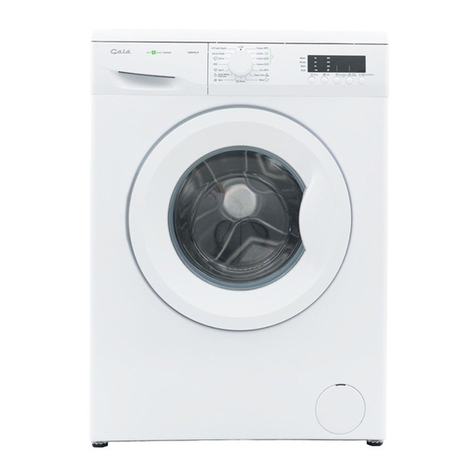
GALA
GALA GM806LK user manual
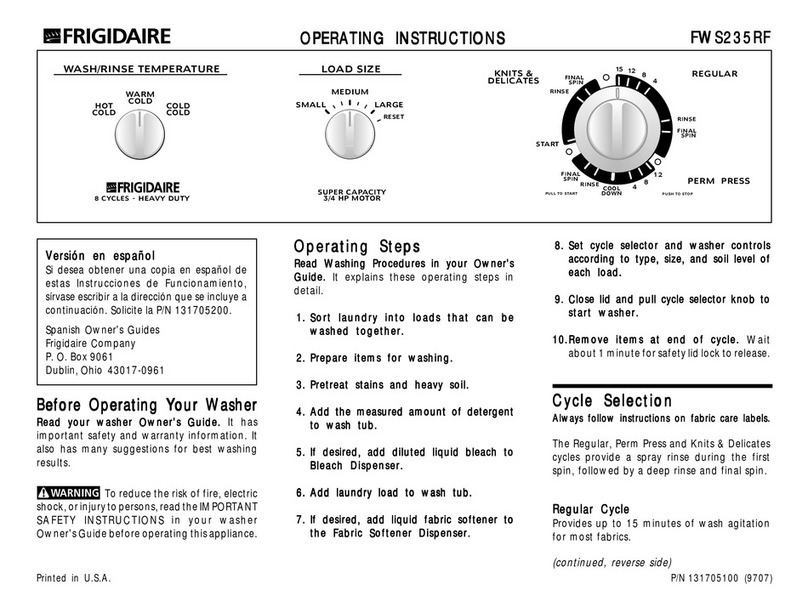
Frigidaire
Frigidaire FWS235RF operating instructions

Siemens
Siemens WM14U840 Series Instruction manual and installation instructions
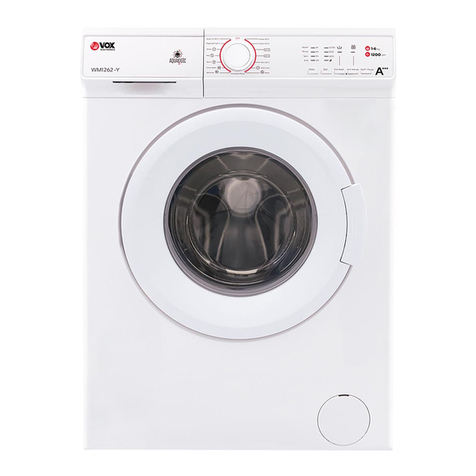
VOX electronics
VOX electronics WM1262 operating instructions

Daewoo
Daewoo DWD-HD94A2 Service manual
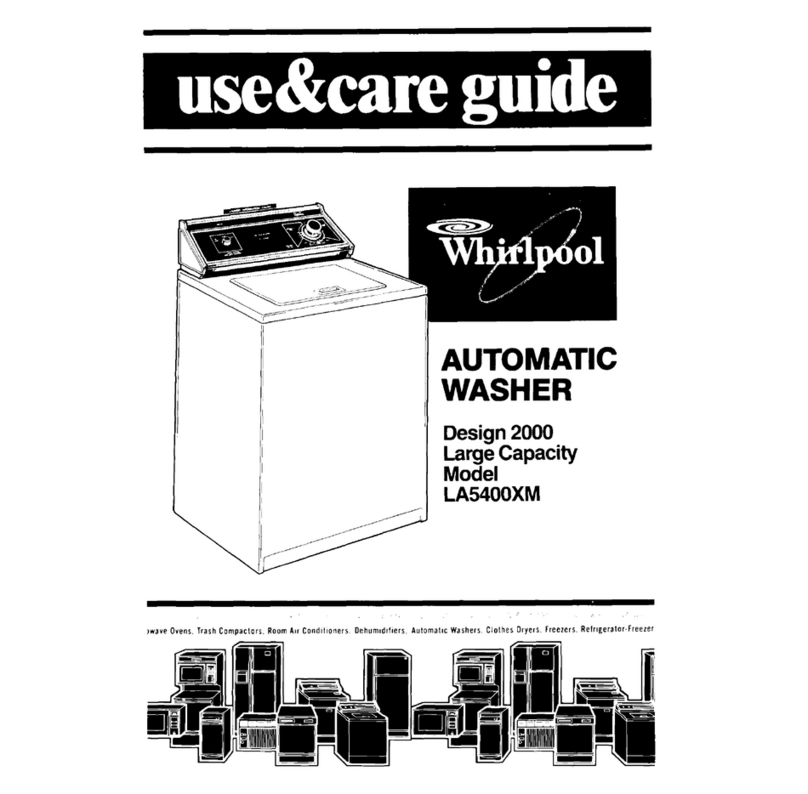
Whirlpool
Whirlpool LA5400XM Use & care guide


